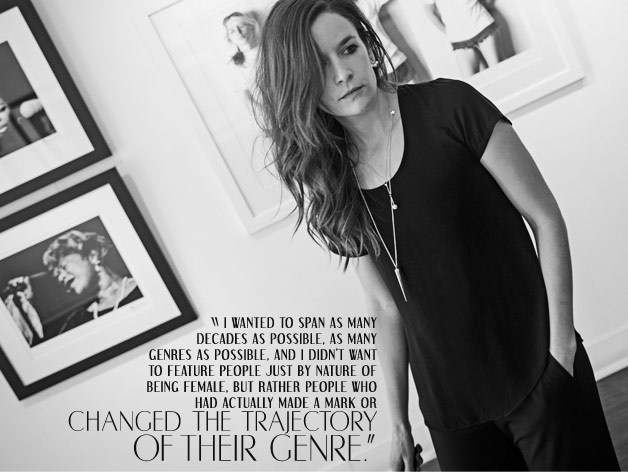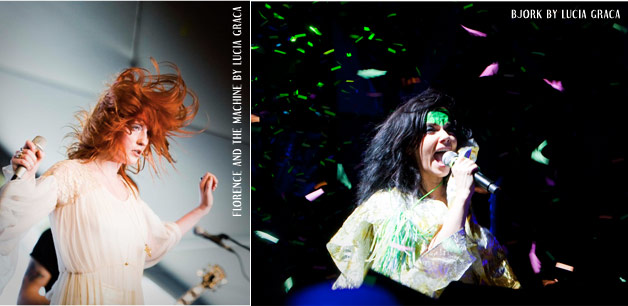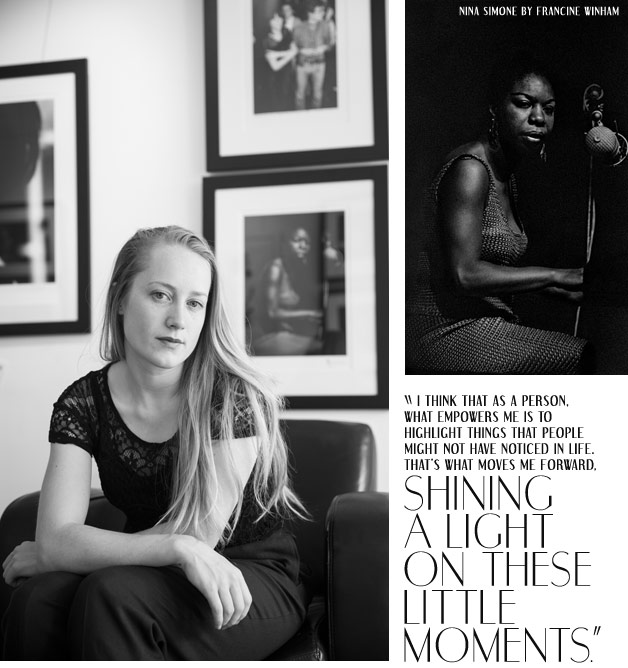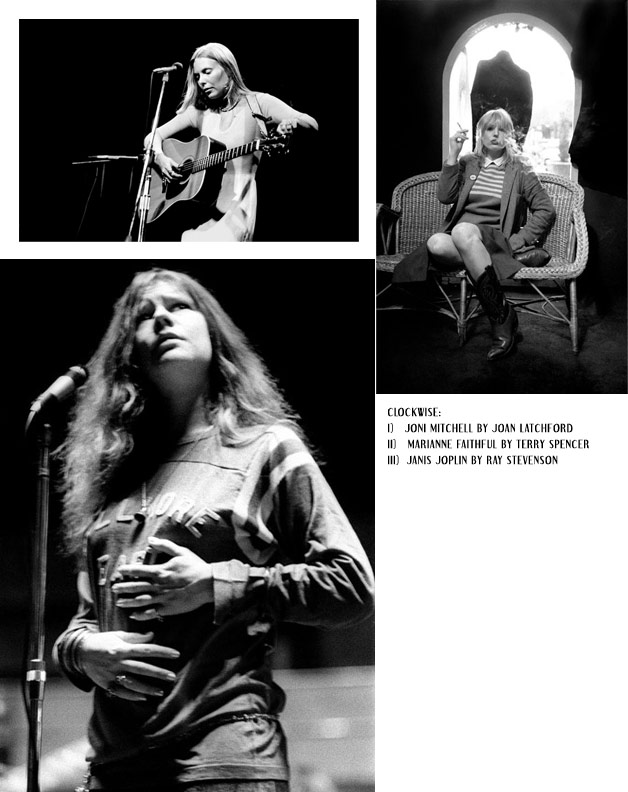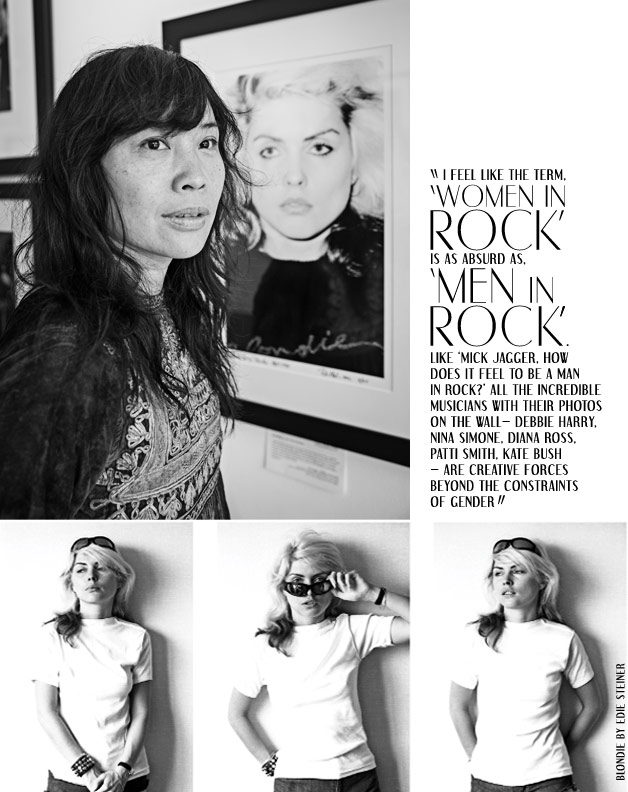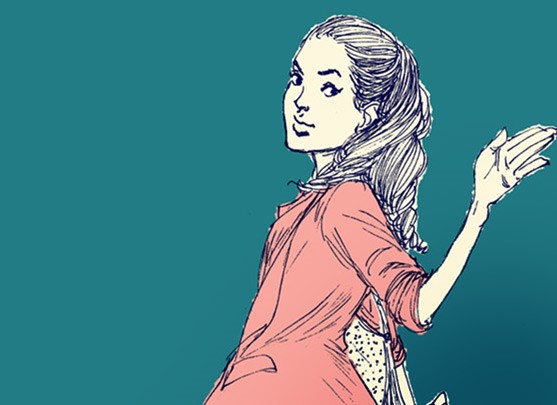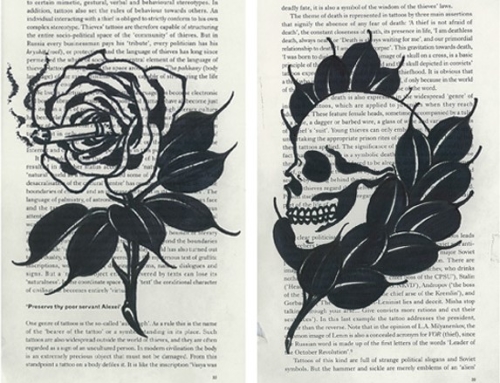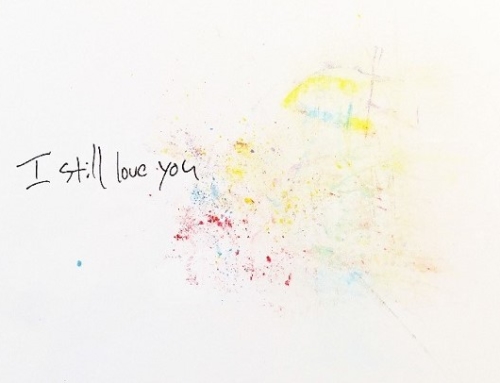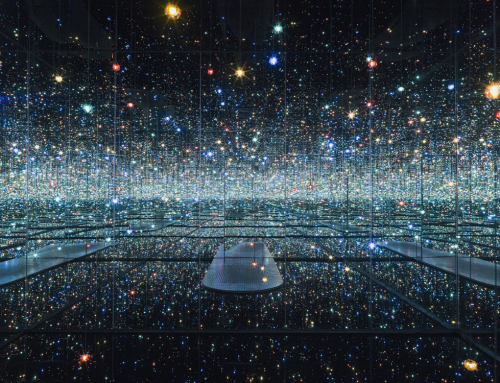Text by Amy Weinstein
Magical, mystical women adorn the walls of the Toronto Analogue Gallery. Photos of legendary artists, from Diana Ross to Janis Joplin to Florence Welch, hang side by side here. Together, the photos depict a story, an ongoing tale made of many different moving pieces: this is the history of “Women in Rock.”
As the title of the exhibit suggests, the show—launched as part of this year’s Contact Photography Festival and curated by gallery owner and photographer, Lucia Graca—is dedicated to female musicians that have become industry icons. What it does not do is engage in a debate about gender inequality. “Women in Rock” is a celebration, an homage to artists that have earned luminary status in their field, regardless of gender.
“I wanted to span as many decades as possible, as many genres as possible,” explains Graca. I didn’t want to feature people just by nature of being female, but rather people who had actually made a mark or changed the trajectory of their genre.” That said, the “diva factor,” was still admittedly on the curator’s mind. “I was looking for people who are amazing performers with a stage presence. People who had kind of broken through the male dominated parts of music.”
The photos hanging on the walls of the Analogue mean to interpolate audiences into the art and life of musicians, spanning decades and genres, and they do just that. “The response has been amazing. People love it,” gushes Graca. “There is so much here, there are different genres. And then there is the fashion element, which has been really fun to explore. I think a lot of the women who have made a name for themselves in music have been really ground-breaking in fashion too. They’ve had fun with their femininity, been playful, been sexy, maybe controversial…obviously, the cone bra jumps to mind. There are a lot of layers to the exhibit, which is why I think it has been so popular.”
The power of the photos’ subjects radiate from behind their frames. Looking at these photos, images that include, Marianne Faithful, exhaling a mouth full of smoke; Bjork singing out on stage, confetti blowing behind her; and Nina Simone, sat at the piano, lost in a song, it’s almost as if one can see the gender gap that once challenged female songwriters and musicians, shift.
To join Analogue in its celebration of “Women in Rock,” we invited three Canadian musicians—carriers of XX chromosomes, of course—to join us at the gallery for a discussion about industry icons and all things music.

A born artist, actress turned folk singer-songwriter Tamara Lindeman of The Weather Station makes music out of creative necessity—as an observer of life. Her lyrics seep deep into the listener’s mind, wicking out emotion. While the steady calm passion in her voice, sung over her acoustic guitar, rouses a reverie of rolling green fields speckled with wild flowers.
With the recent spring release of her latest album, Loyalty, the Toronto-based musician declares herself a nimble and sensitive storyteller, capable of stitching together sentiment with the precision of a physician. While it is the artist’s third album, Loyalty is Lindeman’s first international release, with her two former albums having been distributed exclusively in Canada.
As The Weather Station, Lindeman presents a truly honest approach to song writing. ”What empowers me is to highlight things that people might not have noticed in life. That’s what moves me forward…being able to shine a light on these little moments.”
Positioned to take over Canada’s folk scene with her new record, Lindeman avoids the obvious association with Joni Mitchell (though she is a fan) when choosing a music icon from the gallery walls to feature in her portrait session, instead opting for Nina Simone. She likes a woman who sings with passion…we see the parallel.
What empowers you as a woman working in music?
It’s funny, it actually is a male dominated industry. I feel like this gallery is full of lead singers. Women who led bands. But it doesn’t show that there is still very few female drummers, female bass players, female guitarists. In Toronto, if I want to hire a band, 90 per cent of the people I would look to play with me are men. If I wanted to record a record, I know one or two producers who are female…and 150 male. I think that is more something that is male dominated.
If you could work with one female artist, dead or alive, who would it be?
I feel like it would be super fun to work with Kate Bush because she is so smart and weird. She would probably come up with something really cool.
What motivates you to make art, to write music?
I think I am just inspired to make art because I have to. I think what inspires me is observation. I am always the most moved to write a song when I am angry about something or something seems unjust. Injustice between people I find really calls to me to write about it…just observing the way people are.
What women inspire you in your life?
So many…I am hugely inspired by Jennifer Castle. She is really badass. Definitely my mom is awesome, my grandmother. I have so many great women around me. The women that I sing with in my band, Misha Bower, Ivy Mary, Isla Craig, Carly Aikens, Felicity Williams, they are the most magical women and the best singers ever. Even when they aren’t singing with me, I feel their presence.
Tell me about your new record. What was your creative process like?
It’s my job to write songs. It’s natural. It wasn’t a concept album or anything. I had the songs, and then I named the album Loyalty, and then that really illuminated it for me. It’s about relationships, but not in a romantic sense. It’s about the complications in relationships, and the way that we hold on to each other.
A driving force in Canadian music, art and culture at large, Sook-Yin Lee has had the honour of interviewing some of rock’s most influential artists, as a former MuchMusic VJ and the current host of CBC Radio’s Definitely Not the Opera. A national legend in broadcasting, Lee is also an accomplished actress (Shortbus), filmmaker (Toronto Stories) and musician. Her latest project JOOJ is a testament to her talent as a recording artist, while the band’s music video for its track “Shoulders and Whisper” (directed by acclaimed up and comer, Brandon Cronenberg) is a demonstration of both Lee’s and musical partner, Adam Litovitz’s, creative wit. For fans of Philip Glass-esque minimalism, who also happen to have a taste for theatrics of a German Expressionism variety, consider JOOJ self-titled debut album, released just last month, an early birthday gift wrapped in ethereal melodies.
It’s apparent from the moment one meets Lee that she is excited by the arts. Upon entering the gallery, Lee is instantly drawn to the exhibit’s many images of Blondie, sharing her personal encounter with Debbie Harry. “I had the opportunity to meet her some years ago, and I was amazed by what a massive head she has. A huge double sized melon to contain major amounts of brain matter. And a beautiful palette for her incredible face.”
What empowers you as a women in this industry? Or is that even a relevant question in your opinion?
It’s not really a question. I feel like it is a non-issue for me. I feel like it is a bit of a label. Like a “person of colour.” I feel like the term, “women in rock” is as absurd as “men in rock.” Like, “Mick Jagger, how does it feel to be a man in rock?” All the incredible musicians with their photos on the wall: Debbie Harry, Nina Simone, Diana Ross, Patti Smith, Kate Bush, they are creative forces beyond constraints of gender. I mean…women fucking rock. And men rock. And this room is a testament to a lot of amazing musicians. I think I feel that it is both empowering and disempowering at the same time. People ask if it a issue to be a person of colour in music, and no, it has never been. I feel like rock and roll has always simply embraced me. It is more journalists and the need to define or sell people. I am not really fond of the term “women in rock.”
Are you inspired by women? One in particular, perhaps?
There have been many. I have interviewed a few women here on the walls. Deborah Harry is a huge inspiration vocally, and just also her presence. I am hugely inspired by the apex of her success with Blondie. She decided to take a break. One of her bandmates, and also her lover, was ailing and she took the time to nurse and support him back to health. To me that was quite a decision to make in the middle of her career. And just as she bowed out, Madonna came to the floor. So she was sort of the next iconic Marilyn Monroe-style blonde in American culture. Without Deborah Harry stepping back, I don’t think that Madonna would have happened. She’s a really interesting woman. Patty Smith as well, I met her. She, of her own volition, just came into the studio one day. She was just walking around, hanging out with a friend, and she decided to see what was up inside the studio. Her record company was not going to allow us to interview her, but of her own volition she came in, and she was so great. She engaged with the steely eye of the television camera, looked directly into the camera, and spoke to various women who happen to be maybe vacuuming in their home at the time, she engaged in a very personal one-on-one conversation with potential viewers. And just had a lot of interest and curiosity in technology, and was very open hearted and wonderful. Later that night I saw her perform, and she saw me pressed up against the front of the stage. She waved and said hello, and she sang and peed her pants. That’s her rock move…to let it all out on stage. So that night she peed in her jeans.
Any other inspirational figures you can think of?
I’m a filmmaker as well, so Kira Muratova is a wonderful Ukrainian filmmaker. I was part of the Odessa International Film Festival, I went there some years ago with a movie I had written and directed, and she had a retrospective. And she’s a very fierce woman; a political woman committed to making movies, beautiful poetic, funny insightful films, and she has had to pay for her movies by working in factories. She was such a legacy. It was very inspiring to hear her speak. And my sister is a huge inspiration too. She is artful and considerate, and she went through a very difficult cancer battle a few years ago, and has come out the other side and is doing really well.
What empowers you to continue to create art and music?
It’s not as a woman. It’s such a blunt word. I think for me, it’s the desire to communicate, the desire to hear others and be heard is key. I come from a family where communication was terrible. My dad survived the Second World War, and my mom the Cultural Revolution. My mom had and continues to battle mental illness. It is such that she is completely incapable of regular communication. That stifling basic home front likely fomented my appreciation for communication and my desire to communicate. Having seen those struggles, and also being muted myself.
Can you tell me about JOOJ? How did the project come about?
I did a video and photography installation at The Ottawa Art Gallery a couple of years ago. It was like walking into a 3D movie. I created the score for that, it was instrumental and there was something in that score that I really liked, so I used those instrumental pieces as kind of sketches, and used them as a diving board to create songs around. I really like the feeling that music gave me, it was this kind of outer space, inner brain space sound, and I really wanted to see if I could create a body of songs that embraced minimalism, melody and beauty. Those were guiding principles when my bandmate, Adam Litovitz, and I sat down over the course of the winter in our studio, and made this group of songs under the name JOOJ.

An emerging artist with a four track EP (plus an EP remix of that same collection of songs) and no record label as of yet, Charlotte Day Wilson, lead singer of The Wayo, is the kind of talent that the term “breakout new artist” was coined for. Still flying under the radar (though the band has already garnered media attention from the likes of Vice by way of Noisey), The Wayo plays what they call “smooth-ass R&B.” So basically, should you feel an affinity with Otis Redding and have a soft spot for contemporaries like Rhye, you’ll wish you had more than four songs to play on repeat—we speak from personal experience.
A creature of passion, Wilson says she is especially inspired and moved by Amy Winehouse, and upon seeing her picture in the gallery, shares that she in fact thinks of the artist “daily.”
Booked as a Discover Artists at this June’s Field Trip music festival in Toronto, The Wayo is on the cusp of a breakout (see, there’s that word again), and we predict Wilson and her band to be signed on to a label and recording a debut record before the end of this year. “I think most of the time when people see us on stage, and they haven’t heard of us before, they don’t expect us to sound how we do,” shares Wilson. “It is always nice to surprise people.” 
As a female in the music industry, what empowers you?
Working with other women. Anytime I cross paths with other female performers or sound technicians, or photographers, it is always a nice and refreshing kind of regroup..because I spend so much time with men. The music industry is, without a doubt, dominated by men. So it is always refreshing to team up with other ladies.
Would you say that from your perspective as a young woman in rock, there are professional hurdles specific to the female gender?
Yes there are, but I don’t like to focus on those because I think that can bring you down. There have definitely been times where I feel like I don’t have the same advantages, or that people don’t expect me to have the same knowledge or language or experience or expertise as them, but I like to prove people wrong.
Tell me about your song writing process. Where does it start?
We just pick up our instruments and start jamming…but we always press record on an iPhone. We just play for hours and then go back, and we all remember the moments where we say “that was something cool, that could definitely be a song” and we flesh out those ideas based on our sessions.
Who are some female musicians that have inspired you?
There’s definitely been a lot of really great ladies. A current one is Nai Palm, she is the singer of a band Hiatus Kaiyote. Looking back…Amy Winehouse definitely, and Nina Simone. Then looking even further back, there are people like Fanny Mendelssohn and Fanny Shulman, some of the first female composers. Fanny Mendelsohn had to compose and publish her music under the name F. Mendelsohn because her brother Felix was a composer and she had to go under his name. But, she got her stuff out there.
If you could work with one female artist, dead or alive, who would it be?
Aretha Franklin. There is just something special about her. She has a huge voice. I have seen her perform four times. She is a queen.











